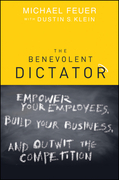
The benevolent dictator: empower your employees, build your business, and outwit the competition
Feuer, Michael
Klein, Dustin
An unconventional philosophy for starting and building a business that exceeds your own expectations What does it require to take a concept rapidly and effectively from mind to market? The Benevolent Dictator recognizes that entrepreneurship is a gauntlet. Those who succeed are benevolent dictators—able to make the intricate process happen in days, weeks and months to win. In more than 52 specific leadership lessons, The Benevolent Dictator gives you no-nonsense how-to advice and examples that have worked. This non-traditional, gung-ho guide is not afraid to lay out the leadership methods that can effectively get a new business off the ground, and through the requisite fast-track growth phases that produce tangible success measured by your bottom line and your wallet. Learn critical specifics on how to move from idea development to build-out, through steps for continuous improvement, and on to the big cash out Features proven tools, strategies, and tactics that will help you bottle entrepreneurial lightning over and over again As the cofounder of office retail giant OfficeMax, the author turned a $3 million investment into a $1.5 billion sale in his 16 years as CEO Beating the competition is never easy. For those times when youneed an iron hand, then you also need the wisdom to know when and how to use it. Whether you're a business student, aspiring entrepreneur, or a practicing executive, you need to discover the winning ways of The Benevolent Dictator. INDICE: Author's note. PHASE ONE START-UP. Chapter 1 Lesson #1: To successfully launch a start-up, there must be a benevolent dictator. Chapter 2 Lesson#2: The best ideas can come from what's right in front of your nose. Chapter 3 Lesson #3: The Law of OPM (Other People's Money). Chapter 4 Lesson #4: Once an entrepreneur, always an entrepreneur. Chapter 5 Lesson #5: It's better to be lucky than just good. Chapter 6 Lesson #6: GOYA The only way to really test an idea. Chapter 7 Lesson #7: Don't underestimate the power of focus, discipline and follow-up. Chapter 8 Lesson #8: Competition stinks. PHASE TWO BUILD OUTAND PUT THE IDEA TO THE TEST. Chapter 9 Lesson #9: Business is a series of goand no go decisions. Chapter 10 Lesson #10: Treat an idea like clay. Chapter 11 Lesson #11: Always be prepared with Plan B and sometimes C and D. Chapter 12 Lesson #12: You'll never reach critical goals without a definitive timetable. Chapter 13 Lesson #13: Never be as weak as your weakest link. Chapter 14 Lesson #14: Raising additional capital requires creating demand. Chapter 15 Lesson #15: Everything you wanted to know about the D word but were afraid to ask. Chapter 16 Lesson #16: Managing people is about achieving objectives through others. Chapter 17 Lesson #17: Good intentions will only get you so far. Chapter 18 Lesson #18: Don't open the doors until the start-up passes the smell testand don't be afraid to call time-out just to be sure. PHASE THREE CONSTANT REINVENTION. Chapter 20 Lesson #20: Pot stirring 101 The key to continuous reinvention. Chapter 21 Lesson #21: Is perception reality? How to manage risk, takechances and remain standing. Chapter 22 Lesson #22: How to keep lethargy at bayor why time is your most precious resource. Chapter 23 Lesson #23: How to avoid analysis paralysis by learning when to make battlefield decisions. Chapter24 Lesson #24: Don't drink your own bathwater; you could choke. Chapter 25 Lesson #25: When the wolf's at the door, what you do you can make the differencebetween living to fight another day or going down for the count. Chapter 26 Lesson#26: Using the mother rule can help you avoid costly hiring mistakes. Chapter 27. Chapter 28 Lesson #28: Survival Math Business is Not a Zero-Sum Game.Chapter 29 Lesson #29: Manage by the three Ps Persistence, Perspiration and Performance. Chapter 30 Lesson #30: You can't live with 'em How to manage primadonnas, employees who think it's not their job, and the perfectionists. Chapter 31 Lesson #31: The Golden Rule of trust and respect: You've got to give to get. Chapter 32 Lesson #32: Why you must look at business through the customer's eyes, not just from an operator's perspective. Chapter 33 Lesson #33: When it's time to pull the trigger and fire a customer or a vendor. Chapter 34 Lesson #34: Spurring growth how to eat an elephant one bite at a time. Chapter 35 Lesson #35: If you don't like the competitio
- ISBN: 978-1-1180-0391-6
- Editorial: John Wiley & Sons
- Encuadernacion: Cartoné
- Páginas: 272
- Fecha Publicación: 18/05/2011
- Nº Volúmenes: 1
- Idioma: Inglés
